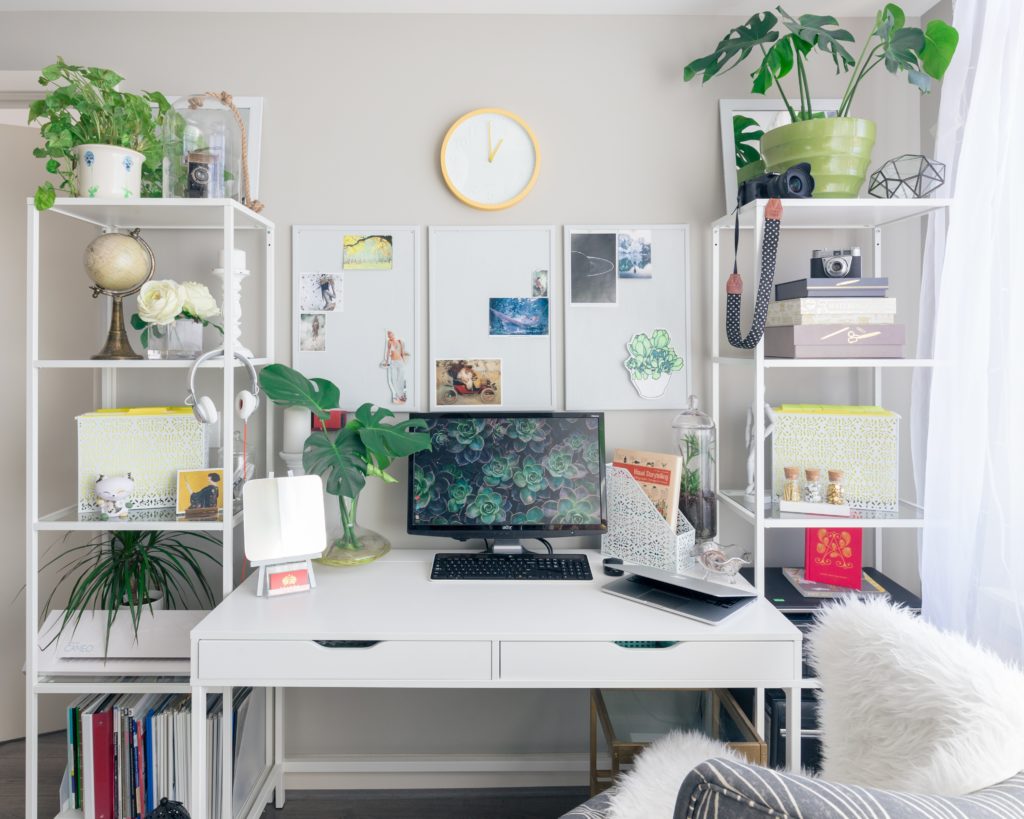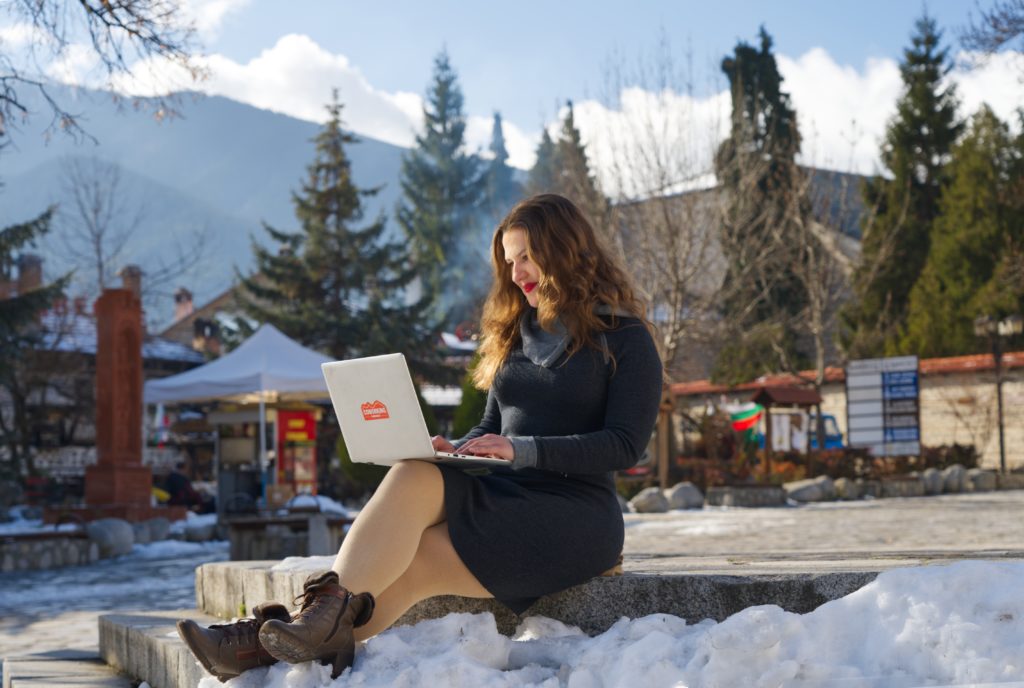The COVID-19 lockdown has shifted our workforce and global economy. The coronavirus has changed everything we usually do at work and has forced us to be creative and adapt to a new way of working. Whenever possible, employers around the world are strongly advocating or requiring people to start working remotely.
Whether you are familiar with working remotely, or this is a new experience for you, following these top ten tips will help you be productive, focused, motivated and successful while working remotely.
My experience working remotely
For the past four years, I have been working remotely as an online professor for Simmons School of Social Work. In addition to working as a medical social worker and blogging, teaching part-time has been a source of joy and growth for me.
To be honest, I was extremely nervous when I first started working remotely as an online professor. I had never taught courses online, and had only taken one online course during my entire academic career. I had a lot to learn and numerous fears to conquer.
Without a doubt, the Simmons online teacher training program prepared me to teach my first online course. The skills I learned in the training course increased my confidence and decreased my anxiety.

Over time, I figured out an organizational system that worked well for me, and I started implementing it regularly. As a result, I saw an increase in my productivity, and decrease in my stress.
Once COVID-19 hit California, I was able to adapt the organizational system I had previously used, so I could begin to work remotely as a medical social worker for the hospital that I am employed by.
Although I have previous experience working remotely, it has still been an adjustment and challenge for me and my team.
Working remotely may also bring up new challenges for you.

We all have our strengths and abilities that support us in being successful in an office environment. You can integrate those same strengths, as well as your resilience, willingness to adapt, learn and grow to be successful while working remotely.
Based on my experiences, as well as what I have learned from others, my top ten tips will help you be a productive, efficient, and successful employee, while working remotely during COVID-19.
1. Create a daily schedule and follow it
The first tip in successfully working remotely is to create a daily schedule that you can control and structure. If you have the luxury of starting your work day at whatever time you choose, then find a time that you are most awake and alert.

Begin your work day and be consistent about your start and end time.
Having a daily routine helps lower your stress and improve your productivity.
“For me the key is to start the day with some time for myself (yoga+meditation) and then have a clearly defined objective for both morning and afternoon. This includes taking minimum 1 hour to cook and eat lunch with my family.”
Eva Herber, Clinical Psychologist
First, before I begin my work day, I use my “commute time” to take a 15 minute walk in my neighborhood. Starting the day off with movement helps me feel grounded.
Second, I meditate for 10 minutes and make myself a cup of tea. This helps me start the day feeling relaxed and at ease.

Next, I log on to my computer and begin my official work day around 8am. As soon as I begin my work day, I write down my schedule, goals and tasks for the day.
Planning your day and making a schedule that you can see, helps you remain productive, engaged and motivated with your work.
It’s important to structure your day and your calendar to optimize your own productivity. To do this, use an online calendar (like Microsoft Outlook or Google Calendar) and block out time in your calendar to reflect your priorities.
To keep communication open with your team and supervisor, you can also grant permission to your calendar so they can view your schedule and availability.
Giving permission to your supervisor to access your calendar is a high level of transparency, which is key when working remotely during COVID-19.
This assures your company that you’re working when you’re “on the clock.” In addition, your supervisor can see what projects and meetings you’re involved in, which can show them that you’re on track with your deliverables.
2. Don’t work in your pajamas
During COVID-19, we’re all in lockdown so what is the point of getting dressed, if you’re not going anywhere and no one is going to see you? You are working remotely, so you may be tempted to stay in your pajamas all day.
As tempting as this may be, do not wear pajamas when you are working.

In fact, there are numerous benefits to getting up in the morning and getting ready. Primarily it’s to prepare yourself mentally and make the shift psychologically from “relaxing at home” to “starting your workday.”
The other benefit of getting dressed, fixing your hair and looking presentable, is that you physically feel better. You will also be ready for an impromptu video conference call or meeting.
My morning routine consists of the following: wake up, quick shower, skincare routine and put on comfortable leggings and a dress shirt. Fix my curly hair, otherwise I look like an untamed lion. Voila, I’m ready to start my day!
3. Designate a work station
When you’re working remotely full-time, it’s important to designate and optimize a workspace.
Some of you have an additional bedroom in your house that you can use as an office. Others, like myself, do not have a spare room or office, and have to be more creative.

Having a dedicated workspace helps you, because you naturally go into “work mode” whenever you sit down at your desk.
Your work station should NOT be a space where you usually sleep, relax and unwind. Therefore, do not use your bed or your couch. Instead, find a space (or multiple spaces) that you can optimize as a temporary office station.
While working remotely, my husband and I are both using our dining room table as our temporary office. We have laptops so during the day we move around, and do our work from the kitchen counter or even on our balcony.
It’s not ideal, however, it works for us.
On the other hand, if you’re lucky and have a spare room or office, find a desk, comfortable chair and make sure you have ample lighting. You don’t want to sit in a dark room, because you’re more likely to feel depressed and less productive.
“Take advantage of working from your own space and make yourself 100% cozy. Light a candle, put on some background noise, make a cup of tea, and get to work.”
Catherine Beard, The Blissful Mind
If possible, get a standing desk which really helps minimize the amount of time you sit. If you can’t afford a standing desk, be creative and find a space in your home that allows you to work while standing.
4. Take your lunch and rest breaks
When you’re working in an office, you participate in micro breaks, like talking to your co-worker about their weekend, or laughing while sharing a joke you heard.
When you’re working remotely from home, these micro breaks do not exist.

Therefore, you have to make a concerted effort to take your breaks throughout your day. To do this effectively, you can prepare your lunches and snacks in advance, so you have something ready to go.
Do not eat your lunch or snacks at your desk. Give your body and brain a break, you’ll be a lot more productive in your work day when you do this.

Moreover, you can schedule your lunch and rest breaks in your calendar. When you get a notification, stop what you’re doing, step away from your work, and take a break.
If you have difficulty with remembering to take breaks, try the Pomodoro Technique, which is a fantastic method to schedule breaks into your day.
“I try to draw a clear line between work time and non-work time (as much as possible), including taking a couple of small breaks twice a day. If I can, I try to have lunch with my partner rather than in front of my computer.”
Marianne Okal, Senior Engineer
Most importantly, don’t feel guilty about taking breaks to take care of yourself.
There’s a common misconception that people who work from home are “lazy.” Contrary to that belief, people who work remotely are often more productive, because they have fewer distractions than those working in an office.
Therefore, it’s important that you practice self-care and take breaks to have lunch, a snack or a short walk in your neighborhood.
You’ll be surprised how much better you feel after you take a break. You will also notice that you’re more focused when you resume your work.
5. Prepare healthy snacks
Perhaps you’re tempted to get up and check your fridge or pantry throughout the day, however, mindless eating is unhealthy. Instead, prepare healthy snacks for yourself.
To learn more about good nutrition during COVID-19, check out this awesome article my friend Stephanie Vermillion wrote on Huffpost called “How To Eat Healthy While Working From Home: Tricks to maintain a good food routine while you’re working remotely during the coronavirus outbreak”

Lastly, remember to stay hydrated and set limits on how much caffeine you consume.
Don’t forget that your body is made up of about 70% water. So when you’re well hydrated, your cells are functioning optimally and help you remain focused, efficient and energetic.
Drink a glass of water (not coffee), mid-afternoon when you notice yourself feeling lethargic. You’ll feel better and your sleep will improve at night.

Keep a water bottle next to you and sip throughout the day. Staying hydrated is key to your overall well-being.
6. Exercise, stretch and move
Your body was never designed to sit for 8+ hours a day. Instead, your body was designed to move, stretch and be physically active.
Sitting for an extensive period of time can wreck havoc for your posture and health. According to the Mayo Clinic, research has linked sitting for long periods of time with a number of health concerns like obesity and high blood sugar.
While working remotely, I’ve been sitting a lot longer than I usually do. This has caused a lot of discomfort in my neck and shoulders. I have been doing some yoga at my desk which has alleviated the pain.
Remember, if you are permitted to go outside during COVID-19, then go on a walk, run, bike ride, or hike. If you’re in a complete lockdown, engage in light stretching, stand while working and try different home exercise videos.
It is critical to exercise, stretch and move while you’re working remotely.
Exercise helps improve your physical health, reduces your stress and anxiety, improves the quality of your sleep and bolsters your immune system .
7. Go outside and breathe fresh air
Working remotely during COVID-19 can be daunting for your mental health.
Trust me, I’ve been going through emotional rollercoasters and anxiety spirals, ever since I started working remotely during COVID-19. I am an extrovert, I thrive and get energy from other people.
In addition, I love my job, which requires connecting with people in-person. Now it’s just me, my computer and my partner, all day, every day. I have to make a concerted effort to go outside, otherwise I feel depressed and anxious.

Remember, going outside can be a refreshing escape. In addition, it can help you feel better physically and emotionally.
If you’re living in an area where you are still allowed to spend time outside, take advantage of it, while honoring social distancing.
“We like to take a walk together as soon as our work day is over, which is a great way to unwind. This ritual helps us mark the transition into our home lives so that we’re in a different mindset when we come back to our home.”
Marianne Okal, Senior Engineer
If you can, get some sun, go take a walk, hike or simply sit outside and observe the trees, birds, clouds and sounds around you.
Even if you’re in a lockdown and can’t leave your home, you can still open your windows once in a while and take a breath of fresh air.

I go outside and walk at least three times a day. I notice a significant shift in my mood when I am walking and breathing fresh air. How about you, what differences have you noticed when you step away from your workspace and go outside to walk?
8. Communicate frequently with your team and supervisor
When you’re working remotely, frequent communication is critical. When in doubt, over-communicate with your supervisor and team about anything and everything.

Taking your lunch break early? Great, send a message to your team. Have a personal appointment and not available via phone? Make sure this is reflected on your work calendar and inform your supervisor.
“Micromanagers all over the world are pissed at coronavirus. Coronavirus has shown us that working from home works.”
Tim Denning, Mind Cafe
Open communication and transparency, while working remotely, are key in fostering trust and camaraderie. You can do this by using secure chat, Slack or whichever messaging platform approved by your company.
Another benefit of regular communication is that it helps reduce feelings of social isolation and bolsters connection.

I communicate all day with my team using secure chat. It helps me feel like we’re all together, even though we’re physically apart. In addition to sharing work information, we share inside jokes which helps us feel closer while working remotely.
9. Schedule time to connect virtually with colleagues
When you’re working in an office, you usually find time to connect with your friends and colleagues over lunch or coffee. These social interactions don’t happen when you’re working remotely during COVID-19.
To continue fostering social connections, connect with your colleagues and friends from work through virtual meetings.
Currently, I’m working remotely as a medical social worker. Since I miss my daily in-person interactions with my colleagues at the hospital, I have set up weekly video conference meetings to maintain our connections and friendships. We are able to see each other and share a virtual cup of coffee or meal together.

Lastly, remember that we are all hardwired for connection. Right now, we’re all experiencing the stressors of social isolation because of the coronavirus lockdown and social distancing.
You and your colleagues will notice a significant improvement in your well-being when you all make a concerted effort to connect with each other.
10. Practice self-care and set boundaries
Working remotely during COVID-19 can be trying and challenging at times.
I have been going through an emotional rollercoaster, and have been feeling all the ups and downs. Yesterday, I was crying for 30 minutes and felt down all day.
I miss my colleagues a lot, am worried, sad and anxious because I do not know when I will see them in person again. I am concerned about their welfare since they’re working on the frontlines as healthcare providers.

Practicing self-care has been instrumental for me while working remotely. My daily practice of walking, meditating, taking breaks and connecting with my colleagues has helped me get through each day.
Self-care is critical for all of us, especially if you are working remotely.
To practice self-care, identify behaviors that you can integrate in your daily schedule. In addition, set clear boundaries and avoid blurring the lines between work and personal time.
One way of setting clear boundaries is to communicate to your team and supervisor what your work hours are. Turn off all your work notifications when you’re no longer on company time.
Another self-care activity you can use is a “wrap-up routine” that you initiate 30 minutes before you end your work day.
“I’m practicing forgiveness and compassion, basics of self care and returning to prioritizing sleep.”
Mara Petrick, LCSW Bereavement Counselor
This routine can include turning off your notifications, responding to critical emails, and reviewing your to-do list. If you identify that you still have work to do, write the tasks down and set aside time for later in the evening, or the following day to complete them.
Writing down your future tasks helps prevent the stress and anxiety of thinking about the incomplete tasks left on your to-do list.

Lastly, remember that practicing daily self-care and setting boundaries will help you remain sustainable and ethical while working remotely during COVID-19.
It’s easy to succumb to burnout since we’re all living with a high level of stress, uncertainty, and anxiety. Many people are spending endless hours working at home since they feel like they have nothing else productive to do.
That is an unhealthy approach to work-life balance. There will always be work to do. However, this precious time that you have been gifted to spend with your family and even with yourself, will not always be there.
As a medical social worker, I have worked closely with people who are at end of life. I have never met someone who said “I wish I had worked more.” Instead, their biggest regret is that they wish they had worked less, and spent more time with their family and loved ones.
I want you to download my free self-care guide so you can practice self-care, set boundaries and start separating your “work” from “home” during the COVID-19 lockdown.
Think of what self-care practices you can integrate in your daily schedule and start doing them. Reflect on how you feel when you practice self-care, and internalize that feeling so you remember it and keep doing it.
Wrap-up
Working remotely during COVID-19 has brought unique challenges and opportunities for all of us. Perhaps you love working remotely and you’re thriving from this experience. Or maybe you’re struggling because you feel overwhelmed, isolated and stressed.
What I know to be true is that all of us are resilient beings. Working remotely has encouraged us to be curious, adaptive and creative with our work.
In order to be productive and focused while working remotely, it is important to get dressed and ready every morning, have a daily schedule, and a designated workspace, which helps you get focused.
In addition, taking your breaks for lunch and walks, as well as preparing healthy snacks will help you have energy and motivation to get through each day.
Moreover, frequent communication with your supervisor and team, and meeting virtually with your colleagues are key to fostering your connections. Lastly, practicing daily self-care and setting boundaries will help you remain sustainable and ethical while working remotely.
What has it been like for you to work remotely? What are you doing to stay productive and healthy? How are you engaging with your colleagues virtually? Please share your stories, comments and suggestions below.




